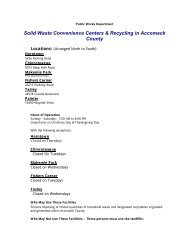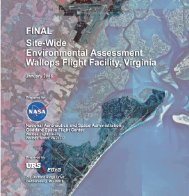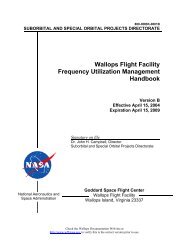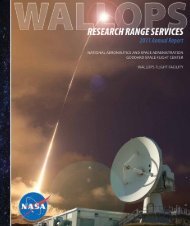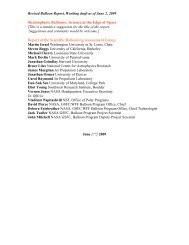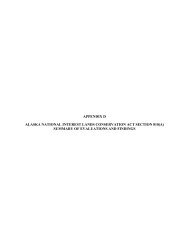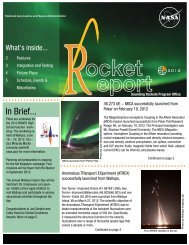Alternative Energy Draft EA - NASA Visitor Center at Wallops Flight ...
Alternative Energy Draft EA - NASA Visitor Center at Wallops Flight ...
Alternative Energy Draft EA - NASA Visitor Center at Wallops Flight ...
You also want an ePaper? Increase the reach of your titles
YUMPU automatically turns print PDFs into web optimized ePapers that Google loves.
Proposed Action and <strong>Altern<strong>at</strong>ive</strong>s<br />
The workspace radius required around each turbine tower during construction activities would be<br />
approxim<strong>at</strong>ely 45.7 meters (150 feet). Clearing of existing veget<strong>at</strong>ion beyond the found<strong>at</strong>ion and<br />
crane pad footprints would not be required. A crane pad would be installed within the 45.7-meter<br />
(150-foot) radius of the wind turbine and would be approxim<strong>at</strong>ely 15.2 meters (50 feet) by 15.2<br />
meters (50 feet). The orient<strong>at</strong>ion and size of the crane pad could vary depending on the<br />
requirements of the wind turbine construction contractor.<br />
Underground power collection lines would be built to interconnect each wind turbine to the<br />
existing <strong>Wallops</strong> Island 12.47-kilovolt electrical distribution system (see Figure 6). These power<br />
lines would be installed in conduit via horizontal directional drilling, which is a trenchless<br />
method of installing underground pipes, conduits, and cables in a shallow arc along a prescribed<br />
bore p<strong>at</strong>h, to minimize wetland disturbance. Step-up transformers for each wind turbine would<br />
be air-insul<strong>at</strong>ed and installed inside the base of the each tower. Additionally, interconnection<br />
switchgear would be installed inside the tower assemblies. All electrical equipment would be<br />
installed inside and out of the we<strong>at</strong>her to minimize potential corrosion on the equipment and<br />
potential wetland disturbance.<br />
2.3.1.2 Residential-Scale Turbines<br />
Up to five residential-scale (2.4 kW) wind turbines would be installed under the Proposed<br />
Action. The represent<strong>at</strong>ive residential-scale wind turbine described in Section 2.1.1.1 and Table<br />
4 would be used. One of the 2.4 kW wind turbines would be installed near the WFF <strong>Visitor</strong><br />
<strong>Center</strong>, and a second would be installed near the security guard st<strong>at</strong>ion <strong>at</strong> the Mainland (Figure<br />
4). The loc<strong>at</strong>ions of the remaining three wind turbines are unknown <strong>at</strong> this time, but would be<br />
placed within the areas th<strong>at</strong> <strong>NASA</strong> has identified as potential suitable loc<strong>at</strong>ions <strong>at</strong> WFF (see<br />
Section 2.1.1.2 for a description of the methodology used to determine potentially suitable<br />
loc<strong>at</strong>ions). Figure 4 shows the potentially suitable areas where three of the 2.4 kW wind turbines<br />
could be installed.<br />
The wind turbines would be constructed with a setback distance of 30 meters (100 feet) from<br />
existing towers, buildings, and trees. The finished subsurface footprint of each 2.4 kW wind<br />
turbine would be approxim<strong>at</strong>ely 1 meter (3 feet) in diameter, with a found<strong>at</strong>ion depth of 6 meters<br />
(20 feet). No transformers or interconnection switchgear would be needed. Standard home<br />
electric wiring (10 gauge) would be buried in a trench from the wind turbine to the desired<br />
facility.<br />
2.3.1.3 Oper<strong>at</strong>ion, Maintenance, and Decommissioning<br />
Oper<strong>at</strong>ion and Maintenance<br />
<strong>NASA</strong> would utilize d<strong>at</strong>a currently collected <strong>at</strong> various loc<strong>at</strong>ions/towers on <strong>Wallops</strong> Island to<br />
monitor wind speed and direction, r<strong>at</strong>her than building a new meteorological tower specifically<br />
for the Proposed Action. Existing WFF maintenance staff along with on-call manufacturer<br />
maintenance support staff would be used to maintain the turbines and transmission system; no<br />
new staff would be hired for the oper<strong>at</strong>ion and maintenance of the turbines. Oper<strong>at</strong>ions and<br />
maintenance staff and equipment would be housed in existing <strong>NASA</strong> facilities, neg<strong>at</strong>ing the need<br />
to construct any new buildings for oper<strong>at</strong>ions and maintenance.<br />
22




